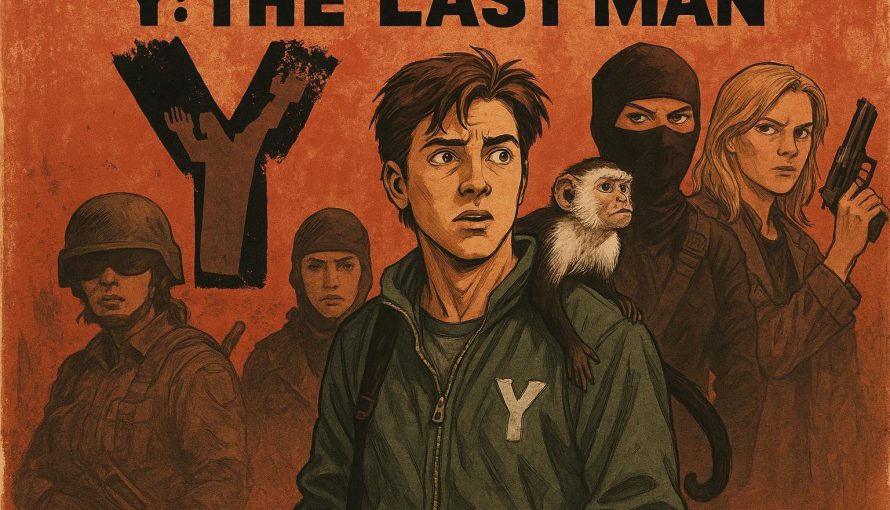Y: The Last Man

Overview of “Y: The Last Man”
Y: The Last Man is a critically acclaimed comic book series created by writer Brian K. Vaughan and artist Pia Guerra. It was published by DC Comics’ Vertigo imprint beginning in 2002 and concluded in 2008. The series is notable for its unique and thought-provoking storyline that explores themes related to gender, survival, and societal reconstruction.
Plot Summary
The narrative centers on a cataclysmic event that wipes out every mammal possessing a Y chromosome, except for a young amateur escape artist named Yorick Brown and his pet monkey, Ampersand. As the only male survivors, Yorick and Ampersand embark on a global journey to discover the cause of the disaster and to understand why they were spared.
Central Characters
Yorick Brown is accompanied by several key characters, including:
- Agent 355
- An operative of a secretive U.S. government agency tasked with protecting Yorick.
- Dr. Allison Mann
- A geneticist who may hold the key to solving the mystery of the gendercide.
- Hero Brown
- Yorick’s estranged sister, who becomes involved with a radical group in the wake of the disaster.
Thematic Exploration
Y: The Last Man examines several significant themes throughout its run:
Gender and Society: The series critically examines gender roles and societal structures, highlighting the dynamics of power and control in a world dominated by women. The sudden disappearance of men forces the women left behind to redefine traditional roles. They must rebuild a world where the usual social structures are upended, leading to dramatic shifts in power dynamics. This shift offers an opportunity to question long-standing assumptions about leadership and societal norms.
Identity and Isolation: Yorick’s journey is not just physical but also an exploration of identity and the search for meaning in a drastically altered world. His unique status as the last man puts him in a state of constant isolation. The story delves into how Yorick grapples with his identity when his most defining characteristic becomes his maleness. This exploration extends to the other characters, who must also reconcile their identities in a world stripped of past norms.
World-Building
The world of Y: The Last Man is intricately constructed with varied landscapes and diverse communities. As Yorick and his companions traverse different regions, they encounter various groups who have adapted to the new world, each in their unique way. Some groups have formed matriarchal societies, while others have become militant in their methods of survival. These varying worldviews contribute to the story’s complexity and provide a backdrop for examining broader themes.
Adaptations
Beyond the original comic series, Y: The Last Man has been adapted into other media. A television series adaptation premiered in 2021, bringing the story to a wider audience while making certain adjustments for a modern context. This adaptation retains the core elements of the comic while reflecting contemporary issues and sensibilities. The adaptation process involves not merely a direct translation of plot but an effort to capture the thematic depth and character development found in the source material.
For further information about the broadcast details of the television series, you can visit the official network sites or entertainment news outlets.
Character Development
The series is lauded for its rich character development, a key factor in its critical success. Yorick is depicted as far from a traditional hero; he is flawed, uncertain, and often portrayed with a sense of humor that belies the serious nature of his predicament. His relationship with Ampersand offers a rare moment of levity amidst the heavier narrative elements.
Agent 355 emerges as more than just a guardian; she becomes a crucial companion in Yorick’s journey. Through her, the series explores themes of duty, loyalty, and personal sacrifice. Dr. Allison Mann’s character provides a scientific lens to the narrative, navigating the tension between knowledge and ethics.
Influences and Legacy
Y: The Last Man stands out in the graphic novel genre for its blend of adventure, dystopian fiction, and social commentary. The series draws from a rich tradition of speculative fiction, echoing themes found in classic dystopian literature yet presenting them through the innovative visual medium of comics, thus engaging a broader audience.
Furthermore, the series has paved the way for similar narratives, inspiring both creators and readers to explore unconventional and speculative storytelling. It has solidified its place as a foundational text in the modern comic book landscape.
Reception and Critique
Upon its release, Y: The Last Man received widespread acclaim from critics and readers alike. It was praised for its originality and intelligent storytelling, setting a high standard for later works in the genre. The pacing of the story, combined with its dedication to character development and thematic depth, has positioned it as a staple in academic discussions on graphic novels.
While the series was widely embraced, it also sparked conversations about representation and inclusivity. Some critiques focused on its portrayal of gender and how it tackles complex social issues. However, such discussions have only deepened its impact, encouraging continued engagement with its narrative long after its conclusion.
Conclusion
Y: The Last Man remains a seminal work in the realm of graphic novels, praised for its storytelling, character development, and socio-political commentary. It continues to be a source of study and discussion among fans and academics alike, making it a significant piece of literature in both comic and broader narrative fields. As it continues to inspire adaptations and debates, its relevance underscores the power of graphic novels as a medium capable of addressing profound and complex issues.